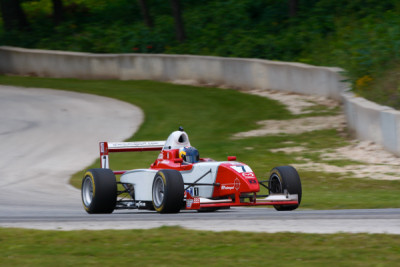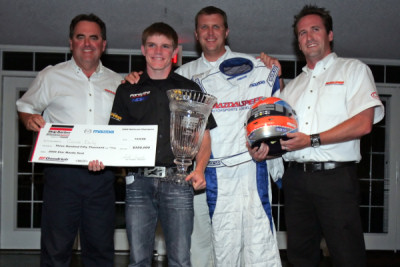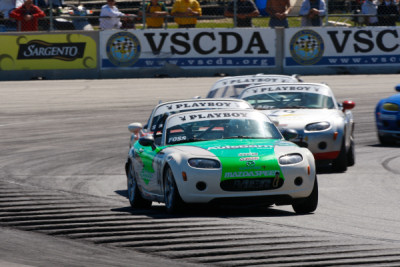The Way It Is/ Appreciating Mazda's scholarship ladder
by Gordon Kirby Who have been the biggest contributors over the last twenty years to developing American open-wheel and road racing talent? Without doubt, it's the Skip Barber Racing School and Series, Jeremy Shaw's Team USA highlighted by this year's spectacular scholarship winners Josef Newgarden and Conor Daly, and Mazda's excellent Mazdaspeed Driver Development Ladder working in company with the Skip Barber group.
Who have been the biggest contributors over the last twenty years to developing American open-wheel and road racing talent? Without doubt, it's the Skip Barber Racing School and Series, Jeremy Shaw's Team USA highlighted by this year's spectacular scholarship winners Josef Newgarden and Conor Daly, and Mazda's excellent Mazdaspeed Driver Development Ladder working in company with the Skip Barber group.
Last month I covered Newgarden and Daly's recent Team USA adventure in the UK and their plans for next season. This week I'm going to take a look at Mazda's young driver development program which deserves a round of applause because no other auto manufacturer provides so much help to aspiring young American racers.
Each year Mazdaspeed's program helps five young drivers move up by paying for the next step in their careers. This year's beneficiaries were 2007 Star Mazda Champion Dane Cameron who raced in this year's Atlantic series; 2007 Skip Barber Champion Joel Miller who competed in the Star Mazda series; Connor De Phillippe, the 15-year old winner of Mazdaspeed's karting shoot-out who raced in the Barber Series; Jason Saini, the '07 Playboy MX-5 Champion who ran this year's Speed World Challenge; and Brad Rampelberg, the '07 SCCA Spec Miata Champion who won the MX-5 shoot-out to earn a season in the Playboy Mazda MX-5 Cup.
Three of this year's five 2009 Mazdaspeed scholarship winners have been determined. John Edwards won this year's Star Mazda championship and moves up to Atlantic next year; Conor Daly won the BF Goodrich/Skip Barber National Championship presented by Mazda and will race in next year's Star Mazda series; and Eric Foss moves up to the Speed World Challenge after winning this year's Playboy MX-5 championship.

© Mazdaspeed
Three years ago Mazda reached a wide-ranging agreement with Skip Barber Racing to supply the school with Mazda sedans and sports cars as well as engines for the Barber racing series. The Barber school uses Mazda sedans and MX-5 sports cars for instruction at five schools across the country and they have become even more popular than the traditional open-wheel school. The Skip Barber Race Series comprises four regional amateur series and an entry level pro series called the BFGoodrich/Skip Barber National Championship presented by Mazda, which awards a $350,000 champion's bonus. New to the whole package this year was the Skip Barber Mazdaspeed Challenge, multiple championships using identically prepared MX-5 Miata race cars.
Robert Davis is Mazda North America's senior vice-president of product development and quality. Davis has been with Mazda for eighteen years and has occupied his current position since 2005. Davis is also an enthusiastic amateur racer, competing regularly aboard a Mazda RX-8 in NASA club races.
"I've been a racer since the early nineties and participated in the Mazda program way before I became responsible for it," Davis remarked. "We're proud of what we've established. Our strategy has always been a bottom-up strategy that focuses on taking care of our customers that are racers, or soloists, or enthusiasts, rather than a top-down strategy like Toyota in NASCAR or Formula 1, which is kind of a carpet-bombing technique.
"Ours is more of a very focused, bottom-up strategy and it has grown over the years. The guys in the competition parts side have grown since we started keeping records of their activities which I think was 1989 or '90. They've grown a great little enterprise.
"Once the amateur side grew to a point where there was a level of dominance in the club racing world of SCCA or NASA we made a strategic decision to go on to professional racing," Davis added. "We viewed that as a way to protect the amateur side and as a way to develop image for the brand that was relevant for the customers we were looking for. And racing is certainly very relevant to what we call the Mazda target which is a very enthusiastic owner."
The current Star Mazda series started in 1985 as the Russell-Mazda series and has developed into a key rung on America's open-wheel ladder.
"The Formula Mazda program was really our first move into the ladder," Davis said. "Our relationship with Gary Rodriguez is twenty-two or twenty-three years old and it's a long and healthy relationship. He runs a great series and I guess we were probably spoiled by his efficiency and ability to put on a good show and develop young talent. I give a lot of credit to the ladder system to Gary because Star Mazda is the lynchpin of the ladder system."
Meanwhile, Skip Barber was building another entry-level open-wheel series originally known as the Barber-Saab, then the Barber-Dodge Series before more recently becoming a Mazda-powered series.

© Mazdaspeed
At the same time Champ Car was looking for a new manufacturer to take over from Toyota as the Atlantic series engine supplier and Mazda stepped forward with a Cosworth-tuned version of its 2.3 liter four-cylinder MZR engine.
"The Atlantic program really came to us via Champ Car and Cosworth," Davis commented. "We loved the history of the Atlantic series and were very concerned when Toyota transitioned out. That was the year after the Trans-Am series went away and nobody on our team here at Mazda wanted to see another classic series vanish. We've got a lot of racers around here so things like that are traumatic to our system. So that opportunity came together and gave us a nice open-wheel ladder system."
Mazda's commitment to helping develop young American driving talent was completed by adding an annual shoot-out for the nation's best karters.
"We had done some work with karting but none of us really understood karting," Davis said. "We had some meetings and took a look at it to try to learn karting and we all agreed that karting is very fragmented. People in the past who have tried to unify karting have failed miserably because it's so fragmented and nobody wants their territory stepped on.
"So we made a conscious effort not to be the eight hundred pound gorilla in karting. We wanted to be the friend of everybody in karting. We didn't want to make any enemies or encroach on anybody's territory. We wanted to become the auto maker that embraces karting and the spirit of the racing. It was a collective effort. Then, when the Skip Barber deal came together, they already had a karting element and we were able to ride onto that and complete our ladder system from top to bottom."
Davis explained how Mazda measures the value of its racing program.
"We measure it a bunch of different ways," he commented. "We obviously measure it in the marketing value of the individual programs--the dollars invested versus the image that we get, which is a standard practice within the industry. We also have a very detailed tracking system of managing our vehicle sales. We aggressively promote vehicles to the entrants and the families of people in karting, the Skip Barber series and all the series up to Atlantic. We keep account of those vehicle sales and report them quarterly to our senior management. We also measure the success of the drivers that go through the system and are successful professional racers.
"We've always said we want to own the driver's story rather than wanting to own the driver. For example, Red Bull wants to own the driver. Every time the driver is shown they want a can of Red Bull in his hand or a Red Bull cap on his head. We've decided when we implemented our strategy that we wanted to own the driver's story. We know we're not big enough to be in victory lane at the Indy 500 with the winner wearing a big Mazda logo on his uniform. We know that's not going to happen because it's beyond our means.

© Mazdaspeed
Mazda's MZR engine races in formula cars, sports cars, midgets, SCORE trucks and even NHRA drag racing but the company's racing engineering effort is focused on its ALMS Lola-Mazda P2 entry and an RX-8 Grand-Am GT program.
"We see the P2 program as the pinnacle," Davis commented. "We've got a balance between a production-based car and a prototype with the RX-8 racing in Grand-Am GT and the Lola LMP2 car."
Of course, Mazda won the Le Mans 24 Hours back in 1991 and also raced a succession of GTP cars in IMSA from 1989-'92.
"Going back to IMSA and world sports car racing in the eighties and early nineties," Davis pointed out, "Mazda has always been willing to run with the big boys in the prototypes and has always been an underdog and been focused on trying to do things differently to reach a goal. Obviously, like everybody else in the industry, we're not always successful. We had a rough year this past year in P2 and we'll soon be announcing some plans about what were going to do next year.
"But we see the P2 program as being very useful for our design engineers and power train development. We're developing a new line of piston engine motors and that new generation motor uses a lot of the technology that the MVRR uses in American Le Mans LMP2. We're trying to take the learning from that partnership into our street cars in 2011 and beyond."
Davis says Mazda's racing program will not stray from its current path.
"We're going to focus on what we have," he said. "We've been involved with the IRL's engine manufacturers' summit, but it's a just a step too far for us, I think, based on our size and our ability. Most people think we've got a big motorsports division but everybody in our motorsports group can sit around the conference table in my office. It's a small group of very motivated people that do everything above and beyond their normal work flow. We have a saying here: The Mazda Way--three guys, a dog and a surfboard."
Indeed, Mazda's racing department totals only eleven people and some of them, Davis included, have other responsibilities beyond racing. It's great to see an auto manufacturer running its racing program in such a lean, mean yet effective manner. Some of the hulking behemoths who've been pleading for federal bailouts in recent weeks could learn a lot if they cared to study how Mazda goes racing.
More importantly, everyone involved in American motor sport should raise a glass of thanks to Mazda this Christmas season for the company's contribution to the sport.
Auto Racing ~ Gordon Kirby
Copyright 2008 ~ All Rights Reserved
Copyright 2008 ~ All Rights Reserved
Top of Page